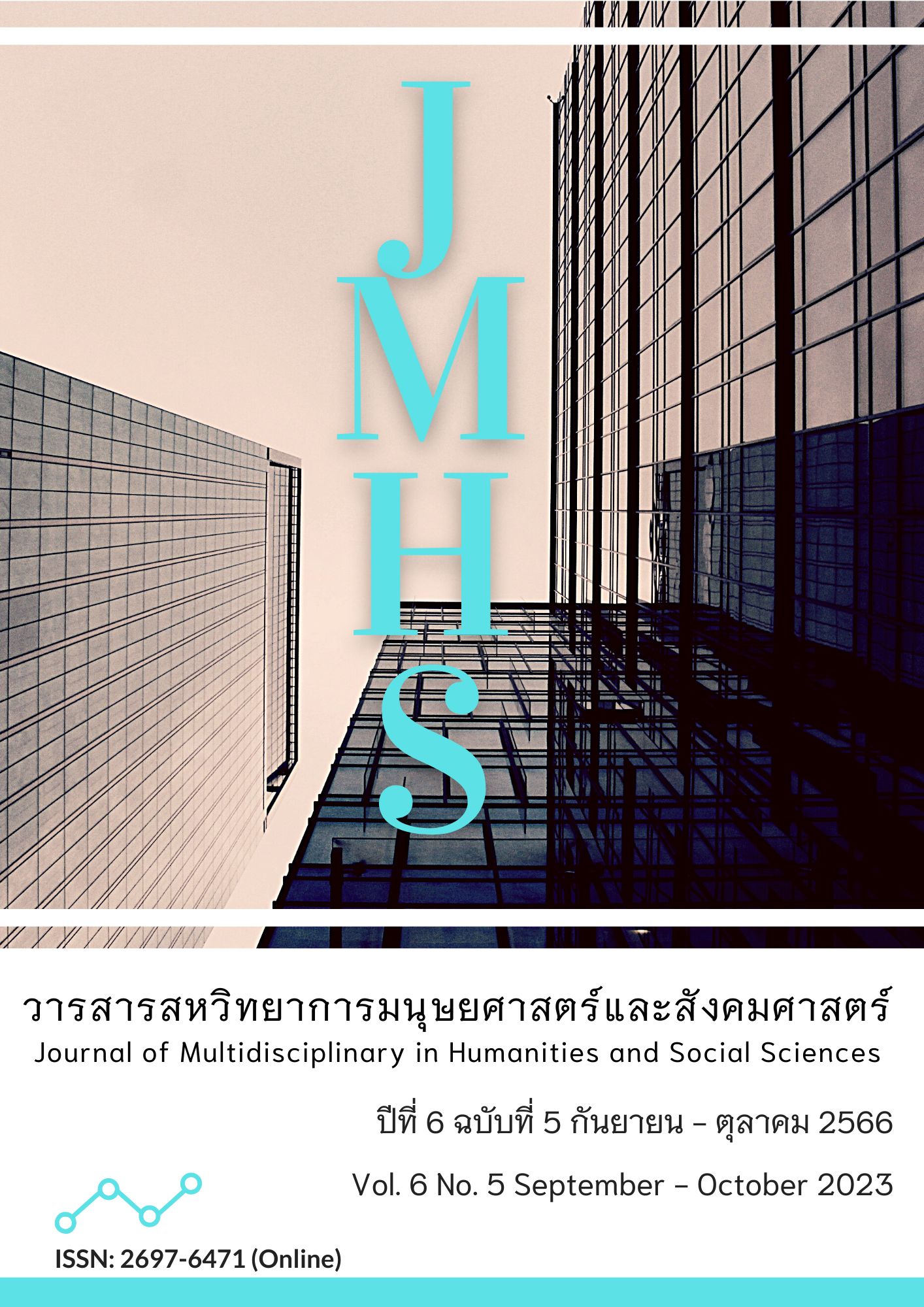Causal Factors Influencing Repurchase Intention of Herbal Scrubs on Facebook Page of Consumers in Bangkok and Its Vicinity
Main Article Content
Abstract
The article aimed to 1) develop and validate a causal relationship model of repurchase intention of herbal scrubs via Facebook pages in Bangkok and its vicinity; and 2) study causal factors influencing repurchase intention of herbal scrubs via Facebook pages in Bangkok and its vicinity. This study was quantitative research. The sample consisted of people who have bought herbal scrubs via Facebook pages and live in Bangkok and its vicinity. By convenience sampling, 380 people the tools used in the research were online questionnaires. The statistics used in data analysis were frequency, percentage, confirmatory factor analysis, and structural equation model.
The results of this research were the development of the causal relationship models, which consisted of four components: 1) satisfaction; 2) service quality; 3) trust; and 4) repurchase intention. The model was consistent with the empirical data to a great extent. The statistic showed CMIN = 300.14, df = 142, CMIN/df = 2.11, GFI = 0.93, AGFI = 0.90, SRMR = 0.07, and RMSEA = 0.05. The final prediction coefficient was 0.87, indicating that the variables in the model can explain the variance of repurchase intention of herbal scrubs via Facebook pages by 87 percent. It was found that the trust had the most direct influence via the repurchase intention of herbal scrubs via Facebook pages. The results of this research are useful for entrepreneurs who sell herbal scrubs via Facebook pages and are utilized in marketing strategies that are suitable for consumers to repurchase in the future.
Article Details

This work is licensed under a Creative Commons Attribution-NonCommercial-NoDerivatives 4.0 International License.
Views and opinions appearing in the Journal it is the responsibility of the author of the article, and does not constitute the view and responsibility of the editorial team.
References
กฤษฎา ฟักสังข์ และ สมชาย เล็กเจริญ. (2564). ปัจจัยเชิงสาเหตุที่มีอิทธิพลต่อความตั้งใจกลับมาซื้อซ้ำแพ็กเกจทัวร์ผ่านแอปพลิเคชันอโกด้าของผู้บริโภคในเขตกรุงเทพมหานครและปริมณฑล. วารสารวิชาการมหาวิทยาลัยหอการค้าไทยมนุษยศาสตร์และสังคมศาสตร์, 14(3), 37-55. สืบค้นจาก http://utcc2.utcc.ac.th/utccjournal/413/37_55.pdf
กรมการแพทย์แผนไทยและการแพทย์ทางเลือก. (2562). พระราชบัญญัติผลิตภัณฑ์สมุนไพร พ.ศ.2562. 121-164 สืบค้นเมื่อ 15 มกราคม 2566, จาก https://www.dtam.moph.go.th/index.php/th/services/laws/enactment/6152-enactment-18.html
ฉัตรสุดา กลิ่นรอด และ สมชาย เล็กเจริญ. (2563). โมเดลความสัมพันธ์เชิงสาเหตุความพึงพอใจในการใช้บริการตรวจสภาพรถมือสองผ่านเพจเฟซบุ๊กของผู้บริโภคในเขตกรุงเทพมหานคร และปริมณฑล. วารสารศิลปการจัดการ, 4(2), 429-443. สืบค้นจาก https://so02.tci-thaijo.org/index.php/jam/article/view/241598
ซุวารี เจ๊ะอาแว, สุไฮนี ขาเดร์, ปิยะนุช สุวรรณรัตน์ และศิริรัตน์ ศรีรักษา. (2564). การพัฒนาผลิตภัณฑ์พอกผิวกายจากเนื้อเมล็ดมะขาม. วารสารการแพทย์แผนไทยและการแพทย์ทางเลือก, 19(1), 135-146.สืบค้นจาก https://he01.tcithaijo.org/index.php/JTTAM/article/view/240002
เดชา พละเลิศ, ธาตรี จันทรโคลิกา, กอบกูล จันทรโคลิกา, พาสน์ ทีฑทรัพย์, ศุภวัฒน์ สุขะปรเมษฐ และ เกษรา กาญจนภูมิ. (2564). ปัจจัยที่ส่งผลต่อความผูกพันกับแบรนด์ของผู้บริโภคและความภักดีต่อแบรนด์ในชุมชนแบรนด์เสมือนจริงบนโซเชียลมีเดียของผู้บริโภคที่ใช้รถกระบะในเขตกรุงเทพมหานครและปริมณฑล.วารสารการจัดการธุรกิจมหาวิทยาลัยบูรพา, 11(1), 67-87. สืบค้นจาก http://ojslib3.buu.in.th/index.php/business/article/view/8044
ปัณฑิฌา ธรรมกุลธารี และ สมชาย เล็กเจริญ. (2565). ปัจจัยเชิงสาเหตุที่มีอิทธิพลต่อความตั้งใจกลับมาซื้อซ้ำเสื้อผ้าแฟชั่นผ่านแอปพลอเคชันโพเมโลของผู้บริโภคในเขตกรุงเทพมหานครและปริมณฑล. วารสารวิชาการมหาวิทยาลัยหอการค้าไทยมนุษยศาสตร์และสังคมศาสตร์, 41(2), 110-126. สืบค้นจาก https://dric.nrct.go.th/Search/SearchDetail/311091
บิวณิชา พุทธเกิด. (2563). อิทธิพลของคุณภาพบริการอิเล็กทรอนิกส์และความไว้วางใจต่อความตั้งใจกลับมาซื้อซ้ำของการซื้อสินค้าออนไลน์ในประเทศไทย. วารสารเศรษฐศาสตร์และบริหารธุรกิจมหาวิทยาลัยทักษิณ, 14(3), 146-158. สืบค้นจาก https://so01.tci-thaijo.org/index.php/ecbatsu/article/view/249536
ปัณณทัต จอมจักร์. (2565). อิทธิพลการยอมรับและการใช้เทคโนโลยี ความพึงพอใจ และความผูกพันที่มีต่อความตั้งใจกลับมาซื้อซ้ำอย่างต่อเนื่องผ่านแอปพลิเคชันออนไลน์เพื่อการซื้อสินค้า. วารสารการประชาสัมพันธ์และการโฆษณา, 15(1), 111-129. สืบค้นจาก https://so03.tci-thaijo.org/index.php/jprad/article/view/255794
ปัณณทัต จอมจักร์, ประยงค์ มิใจซื่อ, ธันยมัย เจียรกุล และนรพล จินันท์เดช. (2562). อิทธิพลของความพึงพอใจของผู้โดยสาร ความผูกพันมั่นหมายของผู้โดยสารและความตั้งใจกลับมาซื้อซ้ำของสายการบินต้นทุนต่ำในกลุ่มผู้โดยสารภายในประเทศ. วารสารสถาบันเทคโนโลยีไทย-ญี่ปุ่น, 7(2), 76-87. สืบค้นจาก https://so06.tci-thaijo.org/index.php/TNIJournalBA/article/view/182306
ลัดดาวัลย์ โชคถาวร, กาญจนา สุคัณธสิริกุล และสรียา วิจิตรเสถียร. (2563). การพัฒนาแบบจำลองเชิงสาเหตุความตั้งใจกลับมาซื้อซ้ำของผู้บริโภคจากการซื้อสินค้าผ่านร้านค้าปลีกออนไลน์. วารสารสำนักวิชาการเทคโนโลยีสังคม มหาวิทยาลัยเทคโนโลยีสุรนารี นครราชสีมา, 8(1), 109-127. สืบค้นจาก https://so05.tci-thaijo.org/index.php/RMUTI_SS/article/view/247676/171046
วรรณเทพ จันทร์จรูญจิต และสมชาย เล็กเจริญ. (2563). รูปแบบความสัมพันธ์เชิงสาเหตุความภักดีที่มีต่อตราสินค้ายูนิโคล่ผ่านสื่อสังคมออนไลน์ของผู้บริโภคในเขตกรุงเทพ และปริมณฑล. วารสารปัญญาภิวัฒน์, 12(3), 120-133. สืบค้นจาก https://so05.tci- thaijo.org/ index.php/pimjournal/article/view/240224
วิรัตน์ ชนะสิมมา และ ทตมัล แสงสว่าง. (2564). คุณภาพการให้บริการที่ส่งผลต่อความพึงพอใจของประชาชนที่ชำระภาษีท้องถิ่นกับเทศบาล ตำบลหนองนาคำ. วารสารวิชาการและวิจัย มหาวิทยาลัยภาคตะวันออกเฉียงเหนือ, 11(2), 15-28. สืบค้นจาก https://so04.tci-thaijo.org/
index.php/neuarj/article/view/246779
ศิริวรรณ์ พันธุ และ ชาคริส ศรีทอง. (2562). ปัจจัยที่ส่งผลต่อการตั้งใจซื้อซ้ำผลิตภัณ์สมุนไพรเสริมอาหารผ่านออนไลน์. วารสารวิทยาการจัดการปริทัศน์, 21(1), 63-71. สืบค้นจาก https://efaidnbmnnnibpcajpcglclefindmkaj/http://grad.vru.ac.th/Database_thesis/thesis/file_pdf/full_57B53170207
สุมามาลย์ ปานคำ และ ณัฐยุพา ทิวากรโกมล. (2564). ปัจจัยเชิงสาเหตุที่มีอิทธิพลต่อความตั้งใจกลับมาซื้อซ้ำตั๋วเครื่องบินผ่านเว็บไซต์สายการบินนกแอร์ของผู้บริโภคในเขตกรุงเทพมหานครและปริมณฑล. วารสารสหวิทยาการมนุษยศาสตร์และสังคมศาสตร์, 4(2), 506-520. สืบค้นจาก http://Users/Acer/Downloads/kchok123420
สำนักงานพัฒนาธุรกรรมทางอิเล็กทรอนิกส์. (2565). รายงานผลการสำรวจพฤติกรรมผู้ใช้อินเทอร์เน็ตในประเทศไทย ปี 2565. สืบค้นเมื่อ 25 ธันวาคม 2565, จาก https://www.etda.or.th/th
อิ๊อิ๊ ปิว และสุนิดา พิริยะภาดา (2562). ปัจจัยที่มีผลกระทบต่อความพึงพอใจและความตั้งใจกลับมาซื้อซ้ำจากร้านเสื้อผ้าออนไลน์ของผู้บริโภคพม่า. วารสารสุทธิปริทัศน์, 33(105), 123-136. สืบค้นจาก https://so05.tci-thaijo.org/index.php/DPUSuthiparithatJournal/article/view/218249
Firmansyah, N., & Ali, H. (2019). Consumer Trust Model: The Impact of Satisfaction and E-Service Quality toward Repurchase Intention in E-Commerce. Saudi Journal of Humanities and Social Sciences, 145, 552–559. Retrieved from https://www.saudijournals.com/media/articles/SJHSS-48-552-559-c.pdf
Hair, J. F., Black, W. C., Babin, B. J., & Anderson, R. E. (2010). Multivariate Data Analysis. (7th ed.). Upper Saddle River, NJ: Prentice Hall.
Hair, J. F., Hult, G. T. M., Ringle, C. M., & Sarstedt, M. (2014). A Primer on Partial Least Squares Structural Equation Modeling (PLS-SEM). California, CA: Sage.
Hoelter, J. W. (1983). The effects of role evaluation and commitment vie identity salience. Social Psychology Quarterly, 46(2), 140–147. Retrieved from https://doi.org/10.2307/3033850
Hu, L.T., & Bentler, P. M. (1999). Cutoff criteria for fit indexes in covariance structure analysis: Conventional criteria versus new alternatives. Structural Equation Modeling, 6(1), 1–55. Retrieved from https://doi.org/10.1080/10705519909540118
Joreskog, K. G., & Sorbom, D. (1984). Advances in Factor Analysis and Structural Equation Models. Lanham: Rowman & Littlefield.
Kline, R. B. (2011). Principles and Practices of Structural Equation Modeling (3rd ed.). New York: The Guilford.
Schreiber, J. B., Stage, F. K., King, J., Nora, A., & Barlow, E. A. (2006). Reporting Structural Equation Modeling and Confirmatory Factor Analysis Results: A Review. The Journal of Educational Research, 99(6), 323–337. Retrieved from https://doi.org/10.3200/JOER.99.6.323-338
Schumacker, R. E., & Lomax, R. G. (2004). A Beginner's Guide to Structural Equation Modeling. (2nd ed.). New Jersey: Lawrence Erlbaum Associates.
Thompson, B. (2004). Exploratory and Confirmatory Factor Analysis: Understanding Concepts and Applications. Washington, D.C.: American Psychological Association.
Ullman, M.T. (2001). The declarative/procedural model of lexicon and grammar. Journal of Psycholinguistic Research, 30(1), 37–69. https://doi.org/10.1023/A:1005204207369


